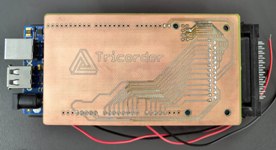A Summer at the Edge
By Tyler Feitshans
Summer at the Edge (SATE), a program sponsored by the Air Force Research Laboratory and led by Research Director Dr. Rob Williams, brings together high school and college level students to develop technology that benefits both soldiers and citizens. This year at SATE, I was given the unique opportunity to lead a project with help from mentors at the U.S. Environmental Protection Agency.
My team’s project, called Project Tricorder, originated from the idea of adding external hardware to smartphones and tablets to collect environmental data on a large scale. I saw this as a clear opportunity to help monitor the world around us through specialized environmental sensors. Our student team and our mentors from EPA’s Innovation Team shared an interest and excitement about developing this idea.
The overall goal of our project is to develop a nationwide sensor grid, measuring everything from air pollution levels to water quality. Project Tricorder aims to make the grid work with any sensor, but we are also developing a sensor prototype. This prototype, called a Tricorder, is a cheap sensor pod with removable sensor bays that allow users to quickly adapt the device to detect the information relevant in a given location. Testing of the prototype has included simple environmental measurements, such as temperature and wind speed, as well as information related to health monitoring, such as carbon monoxide and radiation levels.
Our sensor grid allows Tricorder users to upload data and photos from any location with cell phone access. As data is gathered, it can be displayed in two ways: (1) a graph showing data trends over time; and (2) a map displaying locational data using Google maps. The readily-available data from our project will help communities and policy-makers make quick decisions related to local air quality.
I think the development of Tricorders that work with mobile phones will be a valuable tool in knowing what’s happening in the world around us and will create a number of environmental benefits in the future. This technology also has a number of other applications, specifically in the realms of healthcare and security.
If you’re interested in learning more about our project, you can check out @EPAresearch today for updates from the end of the year SATE Open House. Our EPA mentors will be sending updates and photos of the event via Twitter.
You can also check out a video we made by clicking the link below.
Summer at the Edge – Project Tricorder Video
About the author: Tyler Feitshans will be a Junior Computer Engineering student at Ohio Northern University this Fall. He is currently the Team Lead for Project Tricorder and began participating in the SATE program as a high school student.
Editor's Note: The opinions expressed in Greenversations are those of the author. They do not reflect EPA policy, endorsement, or action, and EPA does not verify the accuracy or science of the contents of the blog.


A Little Tool, Could Be Much Projects……
Time is not change. Constellation of the universes are stable. but the life at the planet is more effective and efficient because the clever of the humans. So, could the people ready to go to beyond their minds..?